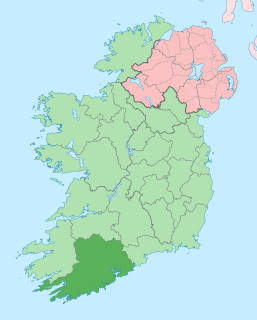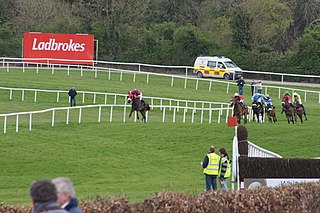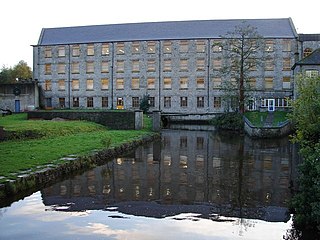
Djebel (1937–1958) was a French Thoroughbred racehorse, who won 15 of 22 races during 1939-1942 including the Prix d'Essai, 2000 Guineas and Prix de l'Arc de Triomphe. He was later a leading sire in France and is responsible for the survival of the Byerley Turk sire line into the 21st century.
The 1939 Grand National was the 98th renewal of the world-famous Grand National horse race that took place at Aintree Racecourse near Liverpool, England, on 24 March 1939.
Tirol was an Irish-bred, British-trained Thoroughbred racehorse and sire. In a racing career that lasted from July 1989 to September 1990 he ran nine times in Britain, Ireland and France. Beginning in September 1989, he won five consecutive races, culminating the following spring with successes in the Classic 2000 Guineas at Newmarket and the Irish 2000 Guineas at the Curragh. After two defeats later in 1990 Tirol was retired to stud, where he had some success as a sire of winners. He died in India in 2007.

Rockfel was a British Thoroughbred racehorse and broodmare, best known for winning two Classics in 1938. In a career which lasted from July 1937 until May 1939 she ran thirteen times and won eight races. Rockfel began her career at the lowest level, being beaten in a selling race, but improved to become recognised as one of the best British racemares of the 20th century. In 1938 she was the dominant three-year-old in England, winning the 1000 Guineas over one mile at Newmarket and the Oaks over one and a half miles at Epsom. In the autumn she defeated colts in the Champion Stakes and the Aintree Derby and was retired after winning her only race as a four-year-old. She produced one foal before dying in November 1941.
Godiva (1937–1940) was a British Thoroughbred racehorse, best known for winning two Classics in 1940. The filly won six times from eight races in a racing career which lasted from 1939 until June 1940. After winning three times as a two-year-old she was unbeaten in 1940, winning the 1000 Guineas over one mile at Newmarket and a wartime substitute Oaks over one and a half miles at the same course a month later. Godiva died within five months of her final race. She has been described as one of the best British racemares of the 20th century.
Habitat (1966–1987) was an American-bred British-trained Thoroughbred racehorse and sire. In a racing career which lasted from April until October 1969, the colt ran eight times and won five races. Unraced as a two-year-old, he proved to be the best European miler of 1969, winning the Lockinge Stakes and the Wills Mile in England and travelling to France to win the Prix Quincey and the Prix du Moulin. He was then retired to stud where he became an outstandingly successful sire of racehorses and broodmares.
Scottish Union (1935–1954) was a British Thoroughbred racehorse and stallion best known for winning the classic St Leger Stakes in 1938. He was one of the highest-rated British two-year-old in 1937, when his wins included the Middle Park Stakes at Newmarket Racecourse. In the following year he ran prominently in all three legs of the Triple Crown, finishing second in the 2000 Guineas and The Derby before his win in the Leger. As a four-year-old he won the Coronation Cup but appeared beaten for stamina in the Ascot Gold Cup before being retired to stud where his record was moderate. He died at the age of nineteen in 1954.
Zagreb was an American-bred, Irish-trained Thoroughbred racehorse and sire. His racing career consisted of only four races as a three-year-old in 1996 and was highlighted by a six length win in the Irish Derby. After his retirement from racing he had some success as a sire of winners in Japan.
Lambert Simnel (1938–1952) was a British Thoroughbred racehorse and sire, who raced during World War II and was best known for winning the classic 2000 Guineas in 1941. As a two-year-old he won once and finished second in the Dewhurst Stakes In the following spring he won the 2000 Guineas, beating a field which included the subsequent classic winners Owen Tudor and Sun Castle. He was beaten when favourite for the Derby and finished unplaced in the St Leger. He won once as a four-year-old in 1942 before being retired to stud. He stood as a breeding stallion in England and Argentina with limited success before his death in 1952.
Sun Castle was a British Thoroughbred racehorse who raced during World War II and was best known for winning the classic St Leger in 1941. After showing promise as a two-year-old he finished third in the 2000 Guineas the following spring but ran poorly when strongly-fancied for the New Derby. He won a race at Newbury in August before taking the substitute New St Leger at Manchester Racecourse. He died in the following spring after contacting tetanus.
Eclair au Chocolat was a French Thoroughbred racehorse and sire. As a three-year-old he won the Grand Prix de la Ville de Vichy and then established himself as one of the best of a strong generation of European horses with wins in the Prix Royal Oak and the Prix de l'Arc de Triomphe. After retiring to stud in 1939 he was taken to Germany during the Occupation of France. His final fate is unknown.
Morse Code was a British Thoroughbred racehorse who won the 1938 Cheltenham Gold Cup. His Gold Cup victory was achieved at the expense of Golden Miller, who was attempting to win the race for the sixth time. He had previously won the Grand Annual Chase and went on to finish second when odds-on favourite for the Gold Cup in 1939.
Brendan's Cottage (1930–1940) was a British Thoroughbred racehorse who won the 1939 Cheltenham Gold Cup. After beginning his career in flat racing he developed into a top-class steeplechaser and won the Gold Cup by defeating the odds-on favourite Morse Code. He never won again and died a year later at the age of 10.
Prince Regent was an Irish Thoroughbred racehorse who won the 1946 Cheltenham Gold Cup. He was the dominant steeplechaser in Ireland during World War II with his wins including the Irish Grand National in 1942. After the war he was able to compete in the major British chases and won the Cheltenham Gold Cup in 1946. He finished third when favourite for the 1946 Grand National and fourth in the race in 1947, carrying top weight on both occasions. He continued to race until the age of fourteen, retiring in 1949.
Fortina was a French-bred Thoroughbred racehorse who won the 1946 Cheltenham Gold Cup. He was and remains the only entire horse to win the race. After establishing himself as a top-class steeplechaser in France he was sent to England and won the Gold Cup on his second British start. He was then retired to become a breeding stallion and became a very successful sire of National Hunt horses.
Lovely Rosa was an Irish-bred, British-trained Thoroughbred racehorse and broodmare best known for her win in the 1936 Epsom Oaks. As a juvenile in 1945 she showed some promise when finishing second in the Queen Mary Stakes and winning a race at Newbury but then showed little worthwhile form until her 33/1 upset victory in the Oaks. She never won again and was retired at the end of 1936. She had some success as a broodmare, most notably being the grand-dam of Wilwyn.
Four Course was a British Thoroughbred racehorse. She was one of the best two-year-old fillies of her generation in England when she won three of her four races, namely the July Stakes, Richmond Stakes and Gimcrack Stakes. In the following spring she won the 1000 Guineas and finished second in both the Epsom Oaks and the Falmouth Stakes. She was retired at the end of the year but died before she could make and mark as a broodmare.
Mesa (1932–1941) was a French Thoroughbred racehorse and broodmare. She showed very good form as a juvenile when she won two races and finished third in the Grand Criterium. In the following year she was sent to England where she won the 1000 Guineas and looked unlucky when finishing third in Epsom Oaks. She also finished second in the Prix du President de la Republique and the Prix de La Jonchere and ran fifth in the Grand Prix de Paris. She made a very promising start to her time as a broodmare before dying at the age of nine.
Wildfowler was an Irish-bred, British-trained Thoroughbred racehorse and sire. He showed very good form as a two-year-old in 1897 when he won three of his five races and finished third in the Middle Park Plate. In the following year he ran fourth in the 2000 Guineas and was fancied for the Epsom Derby before being scratched from the race. He returned in September to win the St Leger, upsetting the Derby winner Jeddah but did not race again. He stood as a breeding stallion in Ireland and France but was not a great success although he did sire a top-class performer in Llangibby and an influential broodmare in Silver Fowl.










